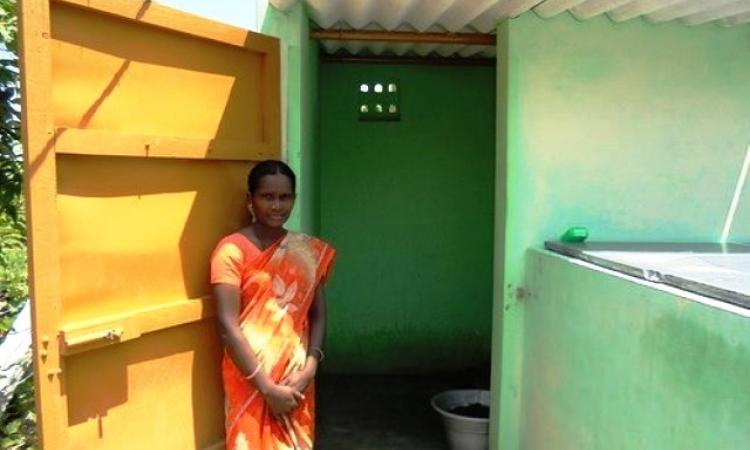
Sanitation coverage in India continues to display marked disparities in access to safe toilet facilities between urban and rural populations across economic and social groups despite some impressive gains made. This lack of access can have deleterious effects on health outcomes and can lead to infections and diseases associated with inadequate water supply and sanitation and can also lead to diarrhoea, stunting and mortality among children.
The paper titled 'Why gender matters in the solution towards safe sanitation? Reflections from rural India' published in the journal Global Public Health, says that a growing number of studies and reports now argue for the need to look at issues related to sanitation from a gender perspective. For example, lack of adequate sanitation is now known to affect women and girls adversely, impacting their health and well-being. Women are forced to face the shame of Open Defecation (OD) due to the lack of consideration to their differentail sanitation and privacy needs and poor access to toilet facilities. There is emerging evidence that suggests that this lack of access to sanitation can also compromise the safety of women in some cases thus exposing them to violence and sexual abuse in urban settings.
In response to the shame and fear associated with OD, women restrict their mobility and also adopt risky practices such as inadequate food and water intake for long hours to avoid the need to urinate or defecate. This lack of adequate nutrition along with poor sanitation and hygiene practices can worsen the situation for pregnant women and lead to poor pregnancy outcomes leading to maternal and child under-nutrition.
Importance of demand-driven approaches to sanitation
Recognising these issues, the Government of India has implemented the Total Sanitation Campaign (TSC) to eradicate OD from rural India. The TSC, revamped as Nirmal Bharat Abhiyan (NBA) in 2012, was initiated in 1999 to promote toilet construction and use in rural India. However, studies highlight that subsidy-driven interventions (like the TSC) focused on latrine construction have not yielded results as: 1) they are often controlled by the wealthier people, 2) do not reach the poor, and 3) the toilets are poorly designed and constructed, and culturally inappropriate. Emphasis is also now being placed on demand-driven approaches to sanitation as low demand at the household level is seen as a reason for unsuccessful sanitation interventions.
Impact of poor water and sanitation on women from rural India: The study
In India, studies have largely focused on experiences and effects of poor water and sanitation facilities on poor women in urban slums. However, little empirical evidence from rural India exists. This research therefore discusses the findings of a study that explored the sanitation situation in one of the rural areas of Uttar Pradesh. The key objectives of this study were to:
- better understand gender-based sociocultural norms and practices around defecation among women;
- understand how women perceived their social and health risks associated with OD;
- identify structural drivers leading to poor sanitation and hygiene which need adequate attention in the future.
This research was conducted in six villages from three districts namely, Unnao, Amethi and Sultanpur of Uttar Pradesh. Qualitative methods of data collection including focus group discussions (FGDs) and key informant interviews (KIIs) were used to gather evidence for this study.
Findings of the study
- Adolescent girls were more vulnerable to sexual harassment and assault when they went out for defecation. The need for privacy and dignity was greatly felt in managing menstrual hygiene by adolescent girls.
- Newly married women and pregnant women were at a greater health risk due to self-imposed food restrictions to avoid defecation during the day while married women with children were burdened with domestic sanitation responsibilities. Older women were prone to physical injuries while going out in the fields at night.
- Women expressed the need for household toilet facilities mainly due to reasons of safety and security.
- Toilet construction remained out of reach for the very poor.
- Government-made toilets were poorly constructed, without any doors, roof or safe enclosures, raising safety concerns and making them inconvenient for women.
- Gender inequality in household financial decision making was an important constraint against toilet construction.
The study found that three key structural constraints had an important role in influencing toilet construction and use namely poverty, inadequate sanitation policies and their implementation, and gender-based power dynamics at the household level.
Directions for policy and practice
The study points at the need to review sanitation programmes and policies from a gender lens in order to address the differential sanitation needs of women and girls, and makes recommendations for policy and practice that include the following:
- The need for gender responsive budgeting and planning in the toilet initiative: Women and girls should be consulted and involved in the planning process of sanitation policies and programmes to ensure that their needs are incorporated.
- Promotion of improved sanitation and hygiene that incorporates gender concerns: Interventions that include women and men and address gender concerns can go a long way in promoting improved sanitation and hygiene.
- Strengthen policy initiatives that promote safe sanitation for the poor: This study calls for the need to strengthen implementation of the revised sanitation policy (NBA), through efforts that lead to increase in the subsidy amount for toilet construction and ensure that it reaches the vulnerable populations.
/articles/connection-between-gender-and-safe-sanitation-rural-india